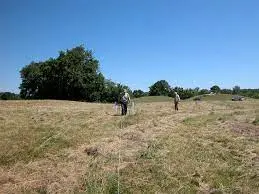
Introduction to Link Farm State Archaeological Area
Importance of the Archaeological Site
The importance of the Link Farm State Archaeological Area cannot be overstated. This area is a rich repository of historical artifacts and remnants of past civilizations that help researchers and historians understand the cultural, sociological, and economic aspects of our ancestors. Its significance extends beyond just being a site for a physical dig. It’s an open book that unfolds tales of human evolution, adaptation, and ingenuity. The artifacts also shed light on the unique technologies, artistic sensibilities, and survival strategies used by ancient societies. Additionally, this site aids the contemporary world in connecting with its roots, so preserving it becomes imperative.
Location and Geographical Features
The Link Farm State Archaeological Area is nestled in the serene landscape of Giles County, Tennessee, United States. Occupying the southern part of the state, the area unveils a rich tapestry of natural features adorned by the winding Buffalo River. Its topography is an interesting fusion of flat fields and rolling hills, providing the ideal backdrop for archaeological excavations. The region is characterised by a moderate climate that swings between warm summers and mild winters. An abundance of native plants and wildlife species grace this area, enhancing its natural appeal. All of these geographical elements contribute to the unique experience that Link Farm offers to historians and nature lovers alike.
History of Link Farm State Archaeological Area
Early Inhabitants and Cultures
The early inhabitants of the Link Farm State Archaeological Area belonged predominantly to the Indigenous tribes who settled near the water sources around what is now Tennessee. These early settlers, dating back to around 12,000 BCE, represented diverse cultures reflecting different periods – from the Paleo-Indian to the Mississippian culture. They richly contributed to the area with some significant archaeological exhibits, such as stone tools and pottery, which reveals a developed culture centered around hunting, agriculture, and elaborate ceremonial practices. The latter inhabitants, notably the Mississippian culture, established complex societal structures and distinctive mound-building practices in the area around 800 CE. Their settlements, characterized by impressive earthwork mounds and advanced artistry, left an indelible imprint on the historical tapestry of the Link Farm State Archaeological Area.
Archaeological Finds and Significance
The Link Farm State Archaeological Area has unveiled numerous valuable archaeological finds over the years, lending a significant voice to the rich history of the region. Artifacts such as pottery fragments, stone tools, and remnants of dwellings offer stunning insights into the lives of the Native American tribes that once inhabited the site. Additionally, researchers found ancient farming tools that provide evidence of early agricultural practices. Detailed studies of these finds have been instrumental in understanding the cultural, social, and economic aspects of the civilization. The archaeological site also carries broader significance as it facilitates the study of indigenous cultures and helps authenticate historical narratives. Each excavation at Link Farm adds layers of knowledge, thus contributing profoundly to archaeological and anthropological research.
Archaeological Exploration at the Link Farm State
Key Archaeological Expeditions
Over the years, ‘Link Farm State Archaeological Area’ has seen multiple extensive archaeological expeditions that have played a vital role in uncovering its hidden stories. One noteworthy expedition was carried out in the late 20th century by the renowned archaeologist, Dr. Carl Addison, who remarkably unveiled the existence of a prehistoric tribe that inhabited the area almost 5,000 years ago. Equally significant was the 2002 expedition led by the State University’s Archaeology Department. Their ground-breaking findings revealed meticulously preserved artifacts that provided a deeper understanding of the tribe’s ways of life and their surprisingly advanced agricultural techniques. More recently, in 2016, an international team of archaeologists discovered prehistoric pottery that stood as a testament to the tribe’s artistic proficiency. Each expedition has progressively unraveled the rich cultural tapestry and the deep historic roots of the Link Farm State, making it a focal point of archaeological interest and study.
Noteworthy Discoveries and Artifacts
“Within the archaeological exploration at the Link Farm State, some truly remarkable discoveries and artifacts have surfaced that stand testament to the rich and vibrant history of this location. One of the key finds includes pottery shards that date back to the Woodland Period, highlighting early human habitation. Anthropologists also uncovered various stone tools and the remnants of ancient agricultural systems, indicating a complex social framework in place. Intriguingly, a collection of well-preserved ceremonial items was discovered, suggesting the existence of a complex religious belief system. Many of these artifacts are adorned with intricate designs, indicative of a highly decorative culture during this period. Furthermore, skeletal remains were also unearthed, offering fascinating insights into the health and lifestyle of the area’s early inhabitants. These noteworthy discoveries have helped reiterate the significance of the Link Farm State Archaeological Area in providing a comprehensive understanding of human history and culture.”
Related: The Biggest Controversies Surrounding Archaeology
Importance of Preservation and Conservation
Threats to the Archaeological Site
The archaeological site at Link Farm State has faced several threats over the years, underscoring the importance of preservation and conservation. Dominant threats include unauthorized pot-hunting, illicit artifact trading, and environmental degradation. The extensive looting of the area has significantly impacted the intactness of the historical strata, disrupting the potential to decipher the chronological sequence of the archaeological record. Serious environmental concerns, ranging from soil erosion to unchecked vegetation growth, have contributed to the disintegration of remnant structures and artifacts. Inadequate fencing and signage have also resulted in inadvertent damage from visitors. To preserve the rich cultural heritage of the Link Farm State archaeological area, stringent measures including increased monitoring, strict access control, an effective regulatory framework, and public education about the site’s fragility and significance must be implemented.
Preservation and Conservation Methods
The Link Farm State Archeological Area is an insignia of the past from which we can glean valuable information about our heritage. Thus, its preservation and conservation are inherent to maintaining its historical integrity. The preservation methods used involve careful documentation of the area, including thorough mapping and photography. All artifacts found are cataloged meticulously to retain their context. Protective structures, such as weather-resistant shelters, are created around the more vulnerable sites to minimize damage from natural elements. Chemical treatments for decay prevention are also applied. Conservation efforts focus mostly on maintaining the site’s sustainability, often including controlling visitor access and public education campaigns to raise awareness about the importance of protecting the site. In essence, these methods ensure that Link Farm State Archaeological Area remains a treasure trove of archaeological material for future generations to study and appreciate.
Visit to the Link Farm State Archaeological Area
Visitor Information and Guidelines
Visiting the Link Farm State Archaeological Area provides a unique opportunity to immerse oneself in the charms of early-period history. Prior to your visit, it’s crucial to bear in mind some guidelines to ensure the site’s preservation for future generations and guarantee a meaningful experience. The area is open to the public from dawn to dusk, seven days a week with no entrance fee. However, please note that excavation, metal detecting, and removal of artifacts are strictly prohibited. The site is primarily a walking tour, so comfortable footwear is recommended to navigate the trails. In case of any guidance needed, there are information boards scattered throughout the area, providing interesting historical facts and pointers. Restroom and picnic facilities are accessible near the parking area. Lastly, keep in mind this area is a vastly important cultural heritage site; treat it with respect and leave only footprints behind.
Experiences and Highlights of the Visit
Visiting the Link Farm State Archaeological Area is an unforgettable encounter with the rich historical significance of the place. The unique convergence of natural beauty and cultural heritage marks the highlights of the visit. The ancient artifacts found throughout the area offer valuable insights into the life and times of early inhabitants, creating a tangible link to our shared past. Hiking through the wonderfully preserved trails amidst lush greenery, one can experience an intense sense of tranquility. The carefully labeled exhibits in the visitor’s center impart interesting tidbits of information, their placement and presentation thoughtfully curated to enable a deeper understanding of the past. Additionally, the special events like pottery workshops and demonstrations of primitive tool use allow active participation and engagement. The archaeological digs can be viewed from safe vantage points, witnessing experts at work unearthing hidden treasures. Each aspect of visiting the Link Farm State Archaeological Area is a step closer to comprehending our roots and unraveling the mysteries of the past.
Conclusion and takeaway
Importance of Archaeology in Understanding History
In conclusion, archaeology serves as a crucial tool for understanding history. The Link Farm State Archaeological Area is a testament to this, unveiling pieces of our past and giving voice to civilizations once silenced. By studying these historic treasures, we can glean valuable knowledge and insights into primitive cultures and lifestyles, strengthening our connection to the past.
Encouraging Community Participation in Preservation
In conclusion, encouraging community participation in the preservation of Link Farm State Archaeological Area is crucial. Involving the community not only helps conserve the area’s rich historical significance but also fosters a sense of local pride and ownership. Hence, each community member’s effort conveys profound importance in retaining this treasured site for future generations.



